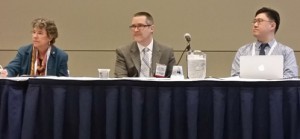
During her Masters Series talk on Sunday morning, Mita Williams, user experience librarian at the University of Windsor (Ont.) Leddy Library, offered an introduction to the many new types of creative spaces that libraries and communities are adopting.
Williams began with c-base in Berlin, launched in 1995 as one of the first independent “hackerspaces” in the world, which inspired many similar efforts in the United States and elsewhere. This first project was a community-based effort to bring together people with similar technical and do-it-yourself interests to learn new skills and work on their projects. Williams said the c-base ethic was independent and countercultural, which contributed to the definition of hackerspace as a physical place with free access to equipment, open access to information, and a distrust of government and business.
Hackerspaces soon evolved into makerspaces, which are a bit more open to the arts and entrepreneurship. “There’s not really a difference between the two words anymore,” Williams said, “but hackerspace is negatively charged, which makes it more difficult to get funding.” Make: magazine, founded in 2005, was a major influence on evolving makerspaces, which are generally “open to artists, scientists, kids, adults, entrepreneurs—essentially everyone.” As a good example of a makerspace, Williams gave i3Detroit, a community-run DIY workshop in Ferndale, Michigan, that describes itself as a “collision of art, technology, learning, and collaboration” and charges members $49 a month.
Another form of creative workshop is the TechShop, a privately owned chain of eight member-based workshops that offers their members training and access to machines for working metal, wood, and fabrics. The TechShop in Detroit is owned by Ford, which offers the space free to company employees who submit ideas that are patentable.
Incubators are another makerspace variety, developed by colleges and universities, economic development organizations, and local government to serve small businesses and enterpreneurs in developing prototypes and developing products. Williams said the University of Windsor runs an incubator called Industrial Courtyard.
A Fab Lab is a space, pioneered by MIT Professor Neil Gershenfeld in 1998, that offers industrial-sized machines that would normally be beyond the budgets of students or other creative types. “The idea is to fill the space with a core set of tools,” Williams said, “all of them open source, and allow people to make almost anything.” Someone designing a product in a Fab Lab in Boston is encouraged to supply the instructions so that someone else in a Fab Lab in South Africa can produce the same item. In 2011, Fayetteville (N.Y.) Free Library was the first library to establish a Fab Lab. In general, Williams said, capital costs for Fab Labs run around $25,000-$65,000.
“The world’s first makerspaces were established long before public libraries,” Williams said. The first Mechanics Institute was begun by industrialists in Edinburgh, Scotland, in October 1821 in order to provide workingmen with books and education in technical subjects. “Although they only lasted about 30 to 50 years,” she added, “there were about 700 in their heyday. As they declined, they often donated their book collections to public libraries that were springing up in the area.” A couple are still around, including Montreal’s Atwater Library and Computer Centre and San Francisco’s Mechanics Institute Library and Chess Room.
“Libraries have embraced the maker movement as their own,” Williams said, “with people at the center, not technology.” They have opted to be more accessible and approachable than commercial shops, promoting creativity and fostering personal expression, she added. “Libraries continue to be a space where the future can be built.”


